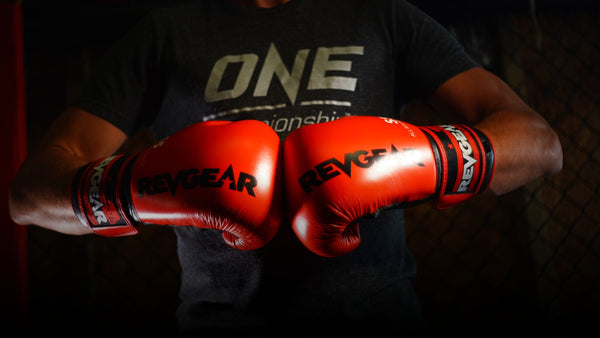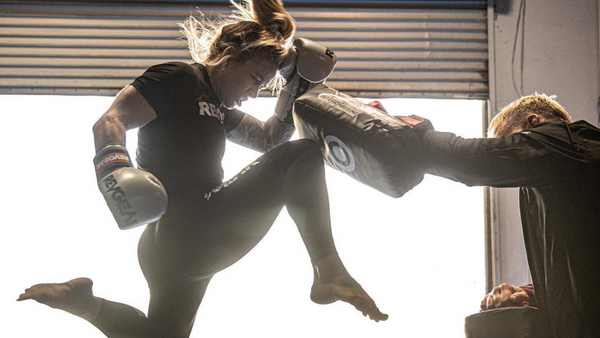Thai boxers come in all shapes and sizes, the gloves are no different and they often reflect the way that an individual fighter trains.
So, what glove size is appropriate for Muay Thai? Here's a guide to help you select the right gloves to protect you, your sparring partner, and even your training equipment during competitions and workouts.
Why are gloves worn?
Gloves are intended to safeguard both you and your opponent, both inside and outside the ring, and are arguably the most crucial pieces of equipment you can wear.
They are frequently mandatory in competitive settings (although bare knuckle and 4oz MMA gloves are becoming increasingly popular).
In contrast to boxing gloves, which concentrate padding on the knuckles for direct punches, gloves utilised for Muay Thai feature padding that is more evenly dispersed for clinching and blocking.
Thai gloves also include rigid wrist support and specific thumb shaping to enable greater dexterity than a boxing glove would necessitate. A well-fitting pair of gloves should fit snugly and minimize wrist movement.
If you find that your gloves aren't quite cutting it, you can wear hand wraps under the gloves to provide additional protection and support.

Competition Thai Boxing Gloves
Competition Thai Boxing Gloves tend to be laced ups at 8oz to 10oz for the most part. Tape and gauze are applied to the fighter's fist before putting on the glove so certain brands and glove shapes can make for an extra tight fit.
Lace-up gloves are preferred for competition as they provide more wrist protection when properly fastened up and have less chance of falling off during the bout.
The wrist section is usually taped over to prevent the laces on the gloves from becoming undone as well as protecting the fighters from the laces during the round (some fighters will rub the wrist on their opponent's face while in the clinch as the compact laces can be painful and even cut the skin).
Heavy Bag Thai Boxing Gloves
Bag gloves are often used in Thailand, but not exclusively. These gloves offer minimal padding meaning that the fighter must carefully place their shots. Angles of strikes must follow the "power line" as Jack Dempsey would say. This encourages fighters to not fall into bad habits which can happen when using 12oz or 14oz.
Taking away that extra level of protection it can ensure that you follow proper form and don't strike in a way that would cause injury without the padding around your knuckles.
Bag gloves for Muay Thai mainly offer protection against grazes, cuts, and abrasions.
While using bag gloves you likely won't be able to throw with full power without risking injury, this also promotes higher-level thinking as you have to take a step back and consider range and timing against the bag with better accuracy to achieve the power line.
Pad work Thai Boxing Gloves

Experience level
If you're a beginner, you may want to start with heavier gloves, such as 12 or 14 ounces.
This will help to protect your hands and wrists as you develop your technique. As you become more experienced, you can move up or down depending on your weight and preference.
Personal preference
Ultimately, the best type of glove for you is the one that feels comfortable and allows you to perform your best. Try on a few different pairs of gloves to see which ones you like best.
Be wary of gloves with an angle around the fist or a prominent thumb placement such as Hayabusa or Yokkao. I have personally used Yokkao and would recommend them, they’re descent gloves and lasted me for years, but the thumb placement encouraged a poor angle on throwing hooks which took some time to adjust for late. A good alternative is the Revgear S5, an all-rounder that doesn't encourage bad technique.
Additional considerations
In addition to the type of glove, you'll also need to consider the closure system. Velcro gloves are generally easier to put on and take off, but lace-up gloves offer a more secure fit.
You should also choose gloves that are made from high-quality materials, such as leather or synthetic leather. These materials will be more durable and provide better protection.
Here are some additional tips for choosing gloves for Muay Thai pad work:
- Check the padding: The padding should be thick enough to absorb the impact of your punches and kicks, but not so thick that it makes it difficult to move your hands.
- Look for good ventilation: The glove should have good ventilation to keep your hands cool and dry.
- Choose a comfortable fit: The glove should fit snugly around your hand and wrist without being too tight.
Sparring Muay Thai Gloves
For sparring most people tend to use gloves at least 120z (if you go lower you may get some strange looks).
Gloves lower than 12oz don’t offer much padding meaning that punches will be more damaging which can cause a plethora of issues, some of which might not be apparent at first.
Safety in the gym should come first, for you and your sparring partners, if you are injured you can’t train, if you can’t train you are at a disadvantage in the ring…
Muay Thai Glove sIze and shape variations
Weight
The size of your Thai boxing gloves depends on your weight and the type of training you'll be doing. For general training, you'll need gloves between 12 and 14 ounces.
These are lightweight enough for mobility and movement while providing adequate protection. For sparring, a heavier glove, typically around 16 ounces, is recommended to ensure optimal protection.
Does glove material matter?
Thai gloves are typically made from real leather, synthetic leather, or microfiber leather.
Real leather is the most durable and breathable option, offering exceptional wear and comfort.
Synthetic leather is less expensive but may not last as long or provide as much breathability. Microfiber leather strikes a balance between durability, breathability, and price.
Fit:
A proper fit is vital for both comfort and performance. The gloves should neither be too tight, restricting blood circulation and causing discomfort, nor too loose, compromising support and stability.
Trial and error is often the best way to find the right fit. Check for a snug but comfortable fit that allows for unrestricted movement.
Closure:
Mouthpieces come with two main closure types: Velcro and lace-up. Velcro is easier to put on and take off, making it convenient for quick training sessions.
Lace-up gloves offer a more secure fit, especially during sparring, but require more time to secure. Velcro is suitable for everyday training, while lace-up is better suited for competition.
Cost:
Price varies depending on the material, brand, and features. Entry-level gloves start around £50, while high-end top-tier Thai brands can cost £300 or more. Higher price typically reflects premium materials and superior craftsmanship.
For long-lasting comfort, protection, and durability, investing a bit more is worthwhile.
Style:
Thai gloves sizes come in a wide range of styles to suit individual preferences.
Traditional tribal designs are popular, while more contemporary designs are also available. Some brands stick to classic styles, while others like Revgear innovate and introduce new designs annually.
Choose a style that resonates with your personal taste and preferences.
































